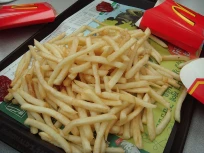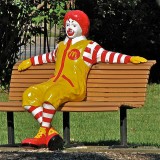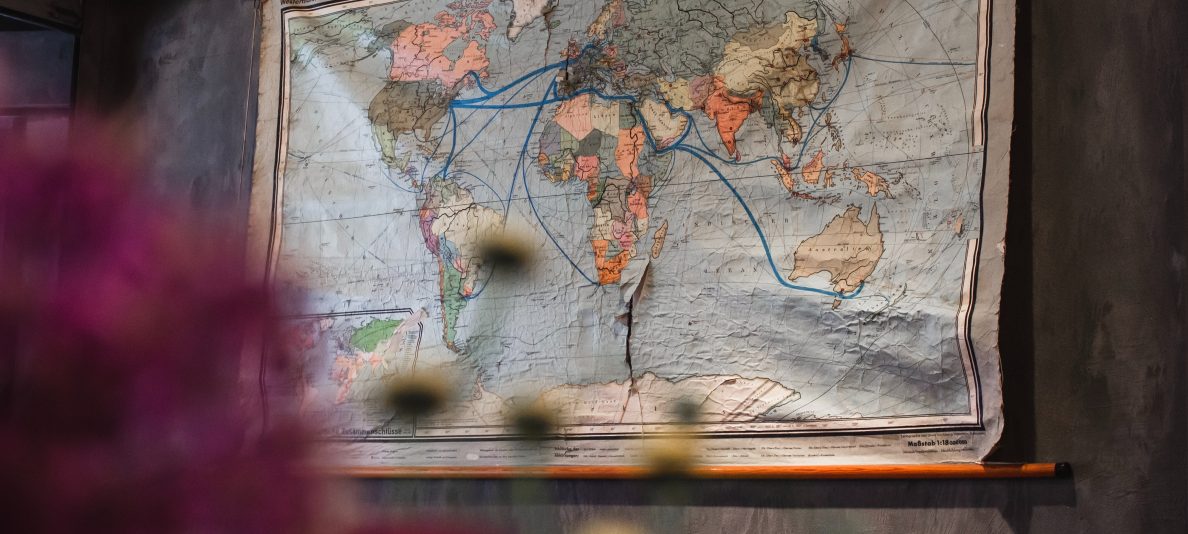
Growing up on a farm, we didn’t eat out much, but I seem to remember enjoying a few Quarter Pounders with fries during my high-school days.
Then, during my time as a student at the University of Missouri-Columbia, my go-to lunch was a salad with a side of fries at the basement McDonald’s on Lowery Mall, across from the library. When I took my daughter for a campus visit to MU a few weeks ago, our student tour guide (who did an excellent job, I might add) pointed out where the McDonald’s used to be. He said at one time it was the highest-grossing McDonald’s location in the US. In the 80s, when I was there, we heard it was the busiest McDonald’s in the world. I think both statements are part of a Columbia urban legend—though I’d love someone to prove me wrong with some documentation.
When my family lived in Taiwan, we found McDonald’s in every city. That was especially welcome when we first arrived and couldn’t speak Chinese. It’s a lot easier to ask for a “Number 5” than to learn the vocabulary for ordering à la carte.
 McDonald’s was popular with the locals, too, especially high school kids. It was common to see them gather there to study or work on class projects. It was a new experience for us to see young people in that group-centered culture pour all their french fries into a pile and share them together.
McDonald’s was popular with the locals, too, especially high school kids. It was common to see them gather there to study or work on class projects. It was a new experience for us to see young people in that group-centered culture pour all their french fries into a pile and share them together.
McDonald’s certainly is a global juggernaut. According to the company website, their more than 33,000 restaurants in over 100 countries serve over 69 million people each day. But there’s more to McDonald’s than just huge numbers. In honor of the chain’s 75th anniversary this year, Reader’s Digest ran a list of “75 Mind-blowing Facts.” Here are my favorites:
#2. The first McDonald’s drive-thru—in Sierra Vista, Arizona—didn’t open until 1975.
#22-22. French fries, McDonald’s best-selling item, were added to the menu in 1949. Before that, it was potato chips.
#50. As the result of a 1973 lawsuit, McDonald’s paid Sid and Marty Kroftt $1 million because the brothers claimed that McDonaldland had stolen the “concept and feel” of their Saturday-morning TV show H.R. Pufnstuf. (Remember that one?)
#58. Giving away (selling?) 1.5 billion toys each year in its Happy Meals makes McDonalds’ the largest distributer of toys in the world. (OK, that’s one of those “huge numbers.”)
#60. One out of every eight workers in the U.S. has at some time had a job at McDonald’s.
#66. Have you heard of the “Big Mac Index”? It was developed by The Economist in 1986 to use the local cost of a Big Mac to compare economies around the world.
I used to tell my Asian college-age friends that I don’t actually like McDonald’s, that most people in the US don’t actually like McDonald’s. But here’s what happens: You’re in a van with a bunch of young people on a trip and you ask them where they want to stop and eat and they say “Anywhere but McDonald’s” and they name other possibilities but when you exit the highway you don’t see any of the places they suggested and you’re running out of time and you decide to eat at the next place you see and—guess what?—it’s a McDonald’s. There’s always a McDonald’s close by, so that’s where you stop. It’s just too convenient.
This guy notwithstanding, McDonald’s burgers don’t garner much praise. In fact, when readers of Consumer Reports rated the hamburgers of 21 fast-food chains, they put the ones from McDonald’s dead last. The magazine called them a “Mc-disappointment.” When our local McDonald’s in Taipei ran out of hamburgers one day (I kid you not), maybe it wasn’t such a bad thing after all.
But there are those “world-famous fries.” McDonald’s calls them “golden on the outside, soft and fluffy on the inside.” I don’t disagree. And a whole lot of other people seem to be on board, as well.
Mark Eichenlaub, a graduate student in physics, decided to figure out just how many french fries McDonald’s has sold. He used the formula

and came up with the figure “4 trillion, give or take a few.” I have a hard time following his detailed explanation (he lost me when I saw that squiggly S-thing before the numbers), but I’m pretty sure his estimate doesn’t even count fries sold outside the US.
Of course, McDonald’s gets knocked for a lot of things besides what’s on their menu. For instance, right now they’re the target of protests over low wages. Sometimes their negatives are symptomatic of the ills of American culture, but they’re magnified with McDonald’s because of the franchise’s large scale. And abroad, their ubiquity and visibility often make them a symbol of Western encroachment.
McDonald’s does give us plenty of reasons not to be “Lovin’ it.”
But again . . . there are those fries.
My second oldest son graduated from university last week. He drove about seven hours round trip to pick up my mother so she could attend the ceremony. The next day I took her back home, with an extra hour added on each way. After I dropped her off, she was worried that I’d fall asleep on the way back, but I told her I’d pull over and rest if I got tired.
 A couple hours from home, in Lebanon, MO, I decided to stop and get something to eat. I parked at a McDonald’s, to go inside and stretch my legs and to use the free wifi. That and I got an order of fries.
A couple hours from home, in Lebanon, MO, I decided to stop and get something to eat. I parked at a McDonald’s, to go inside and stretch my legs and to use the free wifi. That and I got an order of fries.
The lady at the counter greeted me with “Welcome back.” How many businesses can say that to every customer and rarely, if ever, be wrong?
Sounds like framily. And when I say “framily,” I’m thinking of the Sprint commercials with their odd collection of characters—Ronald McDonald, Grimace, Hamburglar, Mayor McCheese, Captain Crook and the rest of the citizens of McDonaldland. It’s an imperfect, dysfunctional framily at times, but it’s still framily.
In the Lebanon McDonald’s, the fries were good, as they nearly always are.
There’s something to be said about consistency. And there’s something to be said about always being close by.
Framily.
(Daryl Chen and Brooke Wanser, “75 Mind-Blowing Facts about McDonald’s to Celebrate Its 75th Anniversary,” Reader’s Digest; “Best and Worst Fast-Food Restaurants in America,” Consumer Reports, July 2014; Mark Eichenlaub, “How Many Fries Has McDonald’s Served?” Quora)
[photos: “McDonald’s,” by Mike Mozart, used under a Creative Commons license; “4 Combos Fries Mix,” by Shippou, used under a Creative Commons license; “plexi • burger.dude,” by Don Shall, used under a Creative Commons license]






